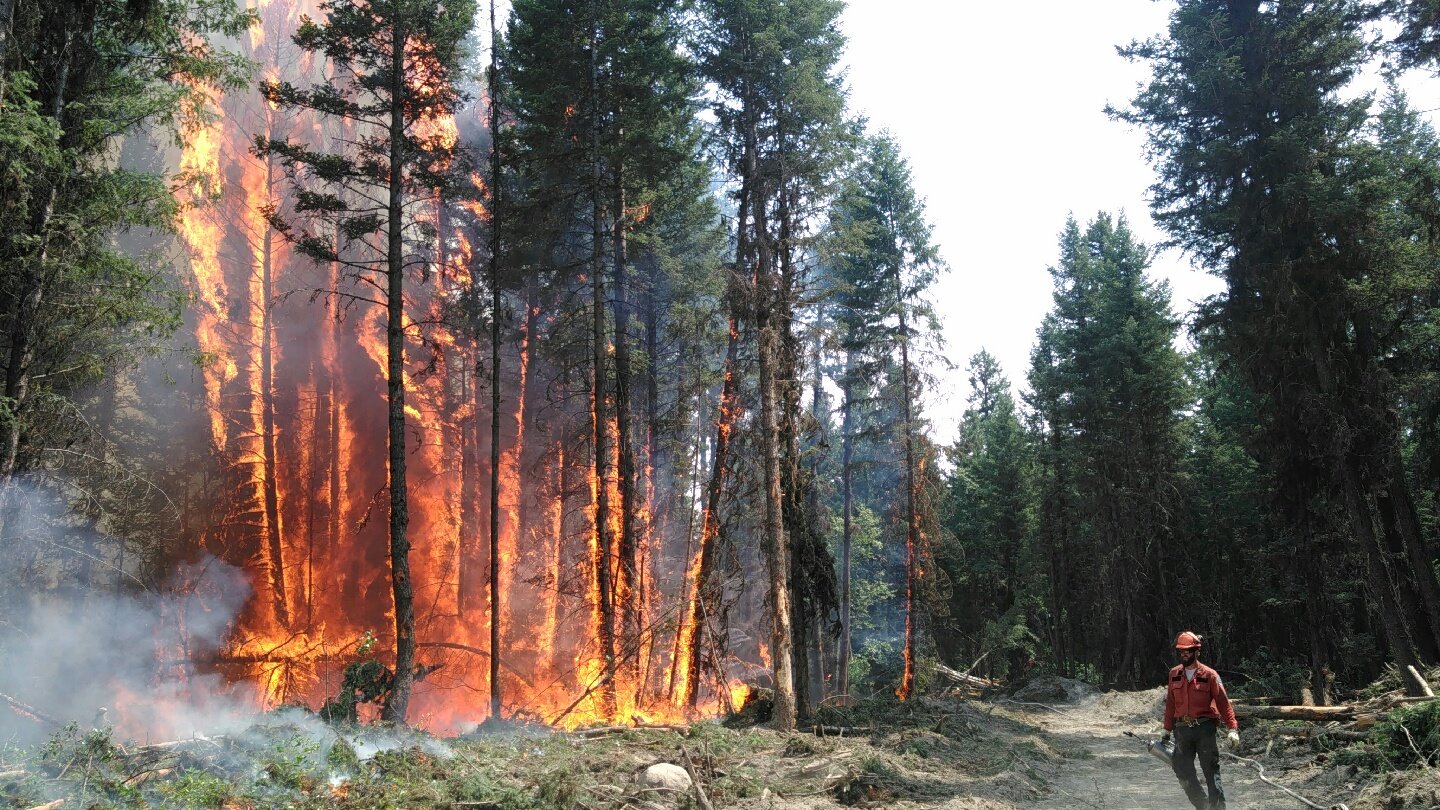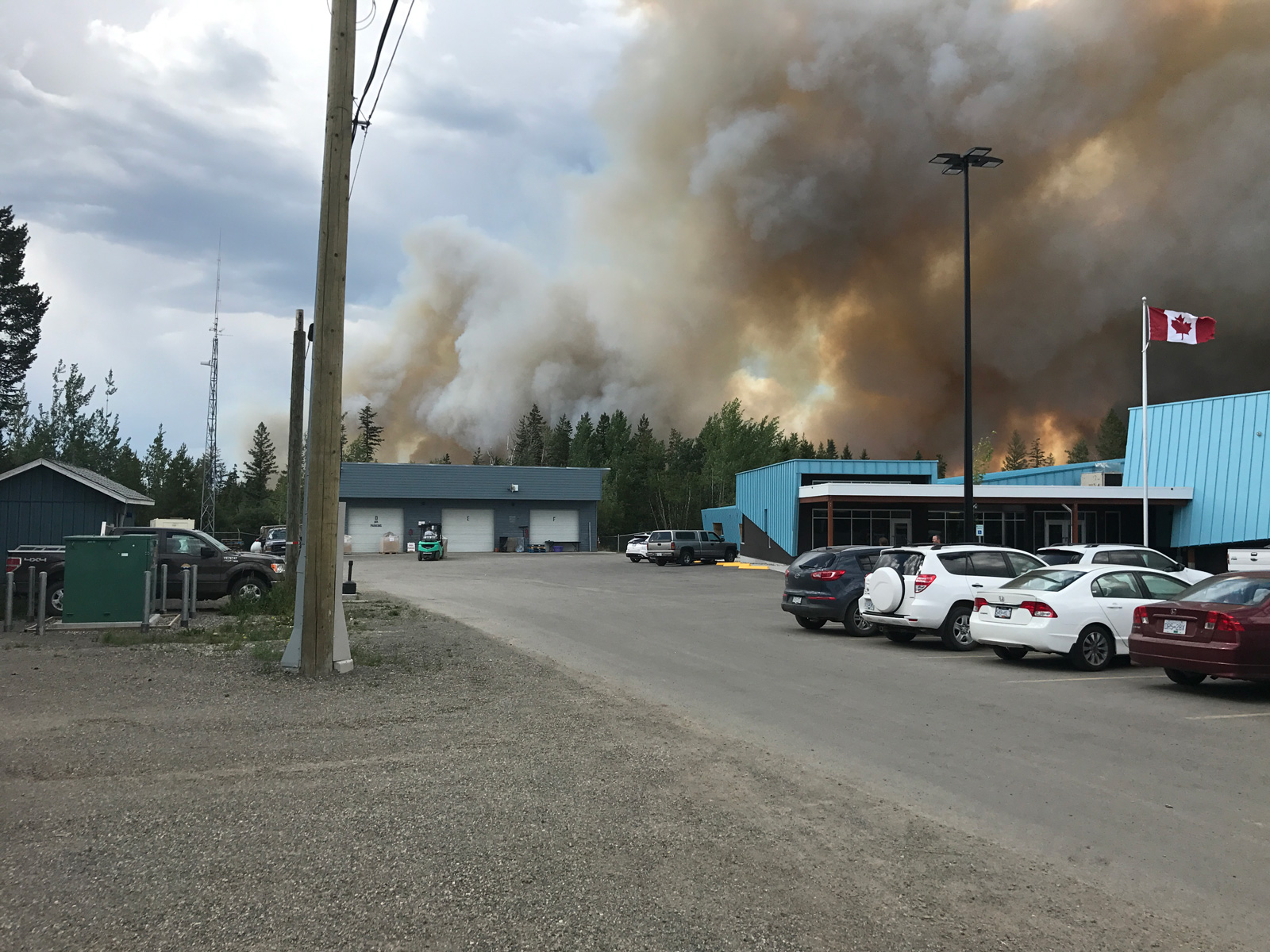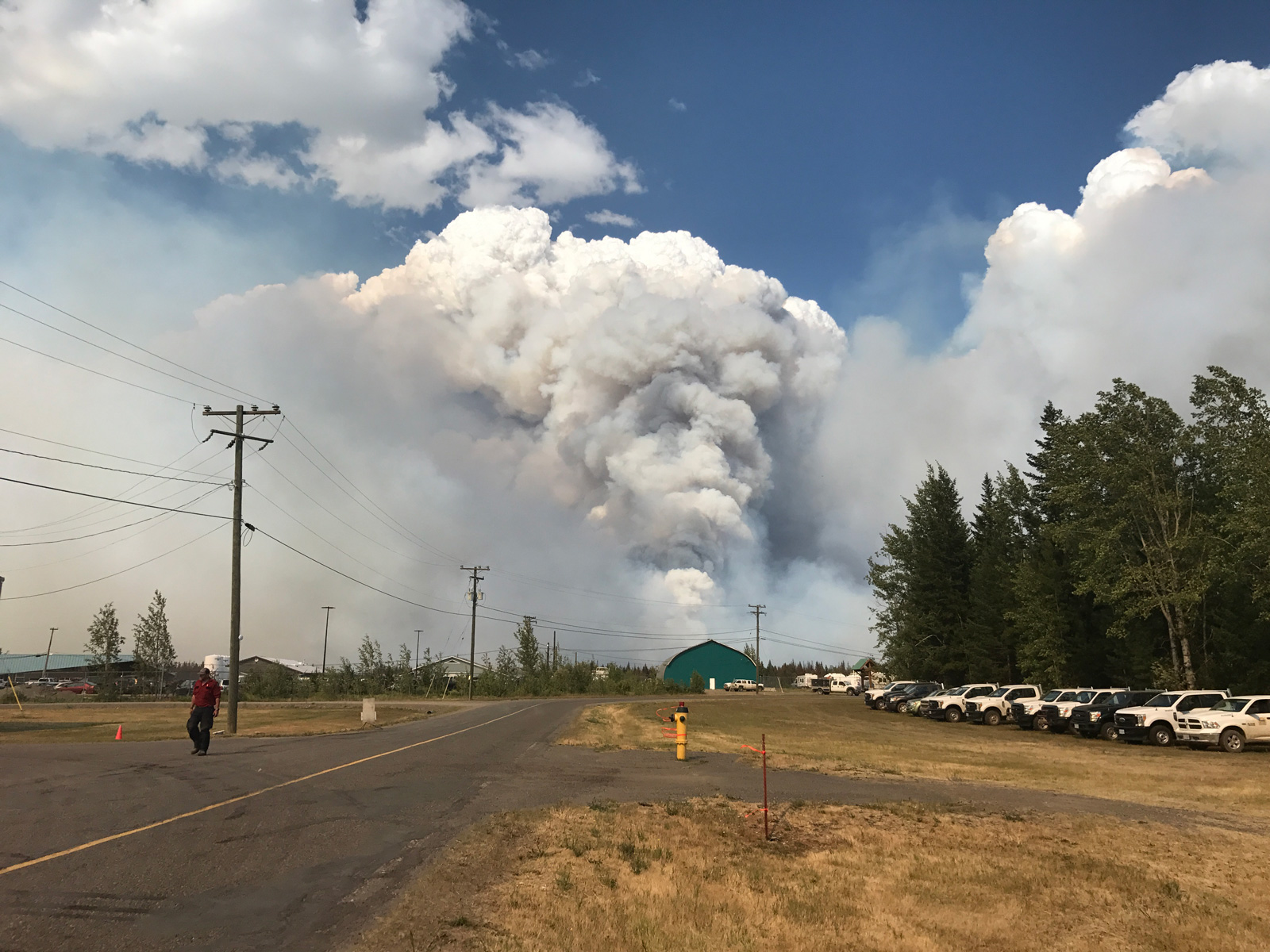Remembering 2017:
Looking back a year later at the start of the 2017 wildfire season for the Cariboo Fire Centre
It has been a little over a year since a lightning storm started 108 fires and saw nearly 7,000 hectares burn on July 7th alone. The BC Wildfire Service looks back at the day that began what would become the province’s worst wildfire season on record by providing the story behind the widely reproduced photo of Trevor Briggs, a BC Wildfire Service firefighter based in Quesnel. Here's the story in his own words:
 ABOVE: Trevor Briggs is pictured here conducting a burn-out to protect the Cariboo Fire Centre and Williams Lake airport on July 8, 2017. Photo by Stephan Karolat, Blackwater Unit Crew Leader.
ABOVE: Trevor Briggs is pictured here conducting a burn-out to protect the Cariboo Fire Centre and Williams Lake airport on July 8, 2017. Photo by Stephan Karolat, Blackwater Unit Crew Leader.
July 7, 2017
July 7, 2017 started out like any other day with the Blackwater Unit Crew based in Quesnel. This included cleaning the trucks, getting our gear fire deployment ready, watching the latest weather reports, and of course, speculating about where the crew could be off to next with active wildfires in 100 Mile House and Ashcroft starting the day before.
Just before lunch, we began to hear the dings of fire reports being logged on our dispatch system. Almost at that same moment, a BCWS contracted helicopter pilot came running inside and said that there was a fire south of Quesnel. He had just seen the lightning strike and the column was starting to grow fast on Green Mountain. Now, all bets were off on which fire we would be deployed to! We loaded up the trucks and stood by for direction from Dan Houser, our crew supervisor. Crews were being deployed throughout the Cariboo, but given the strong winds and dry forests, many of the new fires were beyond initial attack resources. The twenty of us on the crew began to head south to where the lightning had hit.
About 15 minutes south of Quesnel, we drove through Kersley and by the road leading up to the Green Mountain fire, our crew supervisor came on the radio and told us that it was chaos in the Cariboo, and that we were being redirected to protect Williams Lake. The highway from Quesnel to Cariboo Fire Centre by the Williams Lake airport is driven far too often by our crew, but July 7th, 2017 was by far the most memorable.
After driving by the Green Mountain fire, we saw multiple lightning strikes - all of which were instantly turning into smoke columns due to severe fire weather, some of which merged together as we drove by. Nearing McLeese Lake, halfway to our destination, we could see clearly out west towards Nazko and the Chilcotin, and it was just a scene of massive smoke column after massive smoke column. At this point, we knew it was going to be a long summer and a crazy few days ahead for us and the affected communities. As we neared Williams Lake, we again saw multitudes of huge smoke columns and then we heard on our radios the broadcast from the Cariboo Fire Centre Dispatch… “the Fire Centre is evacuating…”
Being on the crew this day was definitely more stressful than most fireline days, however, we were in our element and prepared to do what was necessary to protect threatened homes and values. We helped the local fire department protect the community of Wildwood, north of Williams Lake.
Our objective was to establish anchor points and control lines where possible to limit wildfire spread. This kept us very busy for the afternoon and well into the evening. Due to extreme fire behaviour, it was decided to plan a burn-out around the Williams Lake airport to remove available fuel from the fire’s path.
There was a network of ATV trails and a light breeze that worked in our favour that night, so five of us set out to conduct the planned ignitions over a few kilometres while the heavy equipment was starting to push in control lines by removing organic materials down to the mineral soil. Even after nine wildfire seasons with BCWS, this was one of the most active night burns I have ever been a part of. With it getting very late - or early, depending on how you see it - half of the crew went for some rest and half stayed behind to continue to push in guard lines and develop further plans for the next day.
July 8, 2017
After just a few hours of sleep, we headed back to the Cariboo Fire Centre to relieve the other half of the crew. Cariboo Fire Centre staff had had a hectic night of managing wildfires throughout the region and preparing their own families and properties for evacuation – with many people sleeping under their desks at work.
We only had time for a quick update and briefing with our crew supervisor. The guard lines were complete, but the berm ended up on the wrong side for where we intended to conduct the burn-out. So we set out to fix the berm, set up a hose lay, get water flowing, and would then start the planned ignitions while optimal conditions lasted. The guard line was roughly 1.5 dozer blades wide and was nicely done, other than the berm being pushed on the fire side and not the green (unburned) side, which affects how our burn-offs can be conducted. Once fixed, the guard line was almost three dozer blades wide in the end. Normally this would be excessive, but given the unpredictable fire behaviour, it proved to be critically useful later that day in stopping the advance of the fire.
 ABOVE: July 7, 2017 in front of the Cariboo Fire Centre next to the Williams Lake airport. Photo by Brian Clark, BCWS Safety & Staff Development Coordinator for the Cariboo Fire Centre, who worked closely with the Blackwater Unit Crew to develop objectives during July 7 – 8, 2017.
ABOVE: July 7, 2017 in front of the Cariboo Fire Centre next to the Williams Lake airport. Photo by Brian Clark, BCWS Safety & Staff Development Coordinator for the Cariboo Fire Centre, who worked closely with the Blackwater Unit Crew to develop objectives during July 7 – 8, 2017.
 ABOVE: July 7, 2017 looking towards the Williams Lake airport tarmac, with the Cariboo Fire Centre on the left and Dan Houser, Blackwater Unit Crew supervisor, walking to assess objectives. Photo by Brian Clark.
ABOVE: July 7, 2017 looking towards the Williams Lake airport tarmac, with the Cariboo Fire Centre on the left and Dan Houser, Blackwater Unit Crew supervisor, walking to assess objectives. Photo by Brian Clark.
We had the hose charging with water as fast as we could lay it out; we emptied the warehouse of sprinklers and set them up along the planned ignition line. We now had the guard line set up and began spraying down the green (unburned fuels) on the opposite side of the fire to reduce flammability.
At this point, the second half of the crew arrived back after a few hours of rest. After the burn-out briefing for crews and heavy equipment operators, we could get started. The crew supervisor and I, as a standard practice, grabbed two drip torches for a test burn strip to see what the fire was going to do with the given weather and fuel conditions. Things went very well that morning and we both kept burning, small strips at first, then a few deep passes to pull the fire away from the guard line, and also away from the brand new Cariboo Fire Centre building (staff had only started working in the building a few months before the fires broke out).
We would only come off the line for a brief moment to exchange our empty drip torches for full ones to keep the burn-out momentum going in our favour. In the end, we were successfully able to protect the Cariboo Fire Centre, Williams Lake airport, and Wildwood community area. This is where the photo of me was taken that has now been shared widely by the BC Wildfire Service and media.
From here, the days, the burns, the fires, and the back-to-back deployments throughout the Cariboo and Chilcotin all blend together. Some days we had luck with ample personnel, good weather and winds, but other days not so much. The first few days of the 2017 firestorm will not be forgotten. Most fire seasons from here will only ever be compared to last year, but most likely will not surpass the severity, devastation, and memories.
2017 season quick facts:
On July 7th, a provincial State of Emergency was declared that would last until September 15th, the longest duration in B.C. history.
Over the course of the summer, over 65,000 people were evacuated.
Over 1.2 million hectares were burned.
The province, through mutual resource sharing aid agreements, was assisted by wildfire resources and personnel from every Canadian province and territory, as well as Australia, New Zealand, Mexico, and the United States.
The BC Wildfire Service thanks all those who were involved in the 2017 wildfires – from all levels of government, partner agencies, and especially the volunteers.
